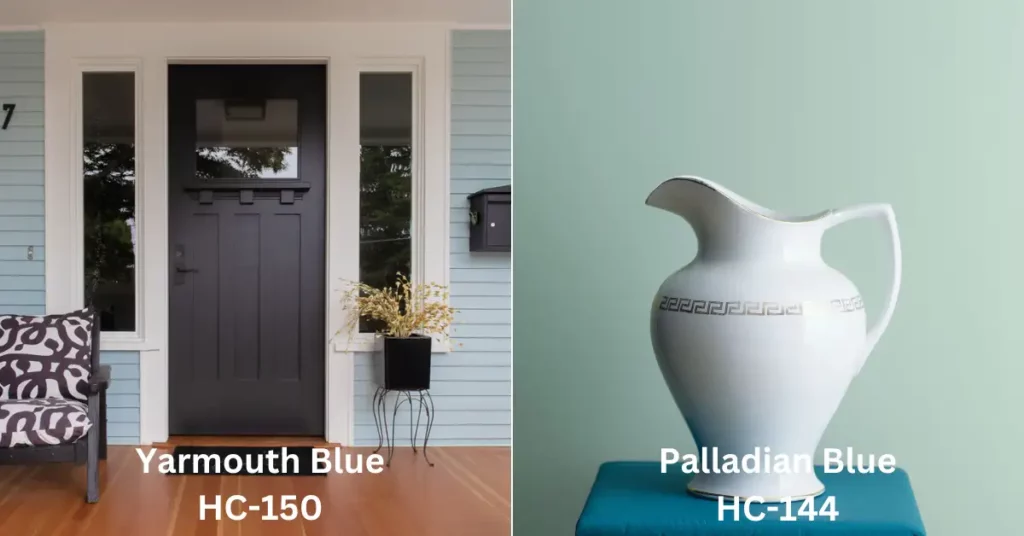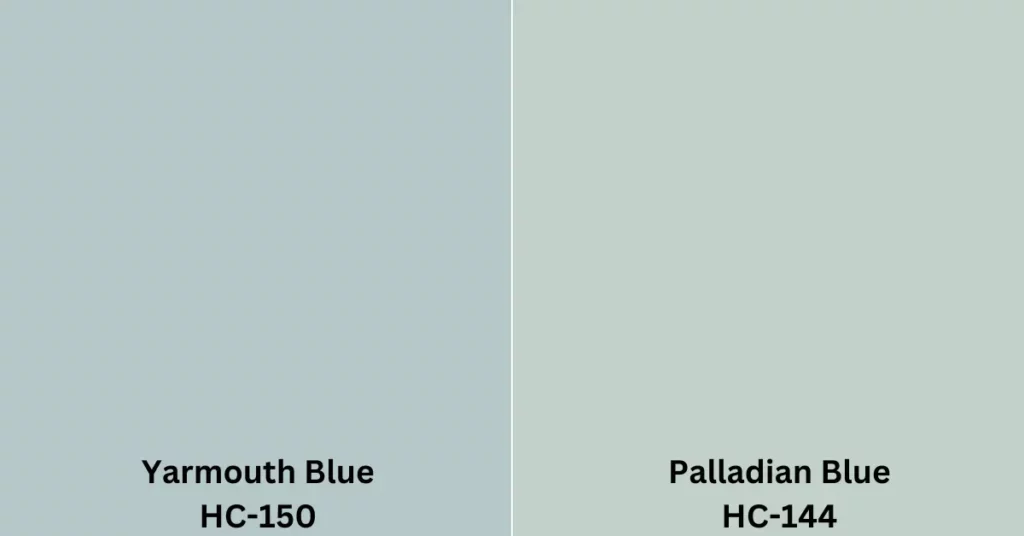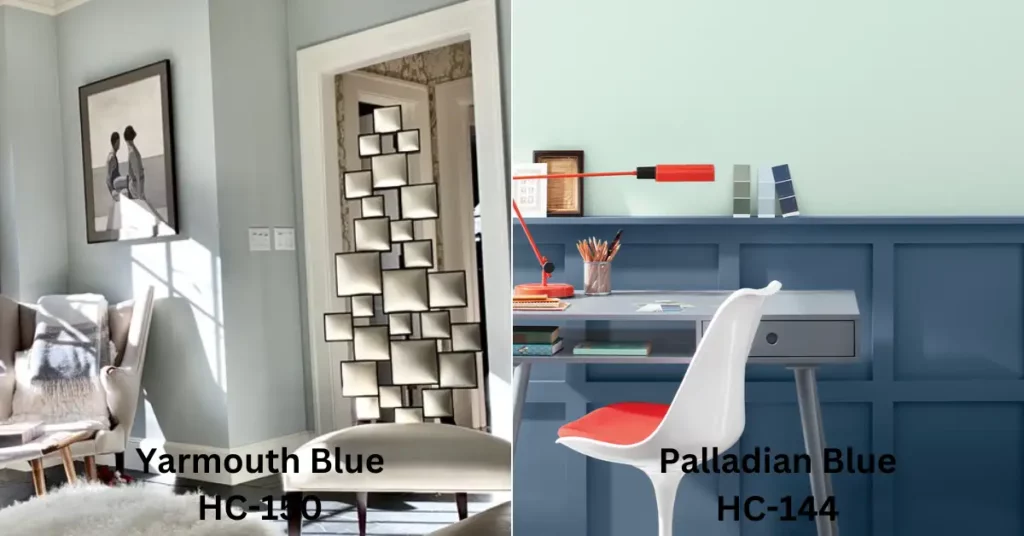When it comes to selecting the perfect paint color for your space, the options can be overwhelming. Yarmouth Blue and Palladian Blue are two popular choices from Benjamin Moore, known for their serene and calming effects.
This article will detailly compare Yarmouth Blue and Palladian Blue, exploring their unique characteristics, undertones, and how they can transform your living spaces. It also featured ideal color combinations for both colors and some factors to consider when deciding on which one to use for your space. Whether considering a room makeover or seeking inspiration, read on to discover the distinctions and applications of these stunning hues.

Yarmouth Blue
Yarmouth Blue, also known as HC-150, is a captivating shade with a hint of sophistication and belongs to the family of blue-gray colors. As part of the historical collection, this timeless hue is often associated with coastal-inspired interiors.
With a medium saturation level, Yarmouth Blue strikes a balance between being bold and gentle, making it suitable for a variety of spaces.
The undertones of Yarmouth Blue lean towards gray, offering a subtle coolness to the overall color. This versatile shade pairs well with both warm and cool neutrals, creating a harmonious ambiance.
It can be used as a focal point in a room or as a complementing backdrop to highlight other design elements. Yarmouth Blue is particularly well-suited for bedrooms, bathrooms, and home offices, where tranquility and relaxation are desired.

Palladian Blue
Palladian Blue, also known as HC-144, is a soft and ethereal shade from the iconic architect Andrea Palladio. This pale blue-green hue is known for its delicate balance between cool and warm undertones, creating a calming atmosphere reminiscent of coastal vistas.
With its light and airy qualities, Palladian Blue works wonders in spaces where you want to evoke a sense of serenity and openness. Its versatility allows it to be used in various rooms, from living areas to kitchens and bedrooms. When paired with crisp whites or warm neutrals, Palladian Blue brings a touch of tranquility and elegance to any interior.
Yarmouth Blue and Palladian Blue: Know The Differences
While both Yarmouth Blue and Palladian Blue fall within the blue family, they differ in their characteristics. Here is a table of differences between them;

| Specification | Yarmouth Blue | Palladian Blue |
| LRV | 55.82 | 60.4 |
| RGB | 181,200,201 | 193,209,201 |
| Color Family | Blue-Gray | Blue-Green |
| Undertones | Gray | Green |
| Saturation Level | Medium | Pale |
| Mood/Atmosphere | Cool, formal | Warm, relaxed |
| Suitable Room Types | Bedrooms, bathrooms, home offices | Living areas, kitchens, bedrooms |
| Ideal Room Size | Larger spaces | Smaller spaces |
| Lighting Effects | Creates a cozy and intimate ambiance | Reflects light, visually expands the space |
| Style Preference | Traditional, Refined | Coastal, Casual |
Remember, they carry their own characteristics so that they might look identical but different in many ways.
Color Combinations
The key to a successful paint color combination lies in the harmonious interplay with other elements in the room. Here are some additional color combinations that can enhance the beauty of Yarmouth Blue and Palladian Blue:
Yarmouth Blue Combinations:
- Yarmouth Blue and Crisp White: Achieve a classic and timeless look by pairing Yarmouth Blue with bright white accents, allowing the blue hue to take center stage while creating a fresh and clean ambiance.
- Yarmouth Blue and Charcoal Gray: Combine Yarmouth Blue with deep charcoal gray accents for a sophisticated and modern aesthetic. The contrasting colors add depth and create an elegant and refined atmosphere.
- Yarmouth Blue and Warm Beige: Pair Yarmouth Blue with warm beige or taupe tones to infuse warmth into your space. This combination creates a cozy and inviting environment, perfect for creating a relaxing haven.
Palladian Blue Combinations:
- Palladian Blue and Soft White: Create a dreamy and serene atmosphere by combining Palladian Blue with soft white accents. This delicate combination enhances the calming effect of Palladian Blue, evoking a sense of tranquillity and peace.
- Palladian Blue and Sand Beige: Embrace a coastal-inspired theme by pairing Palladian Blue with sandy beige tones. This combination captures the essence of the beach, bringing a sense of relaxation and natural beauty into your space.
- Palladian Blue and Coral: Add a pop of energy and vibrancy to Palladian Blue by incorporating coral accents. This lively combination creates a refreshing and uplifting atmosphere, perfect for injecting life into any room.
However, the color combinations depend on personal preference, lighting conditions, and the overall style you aim to achieve. Feel free to experiment and test different combinations to find the perfect harmony for your space.
Yarmouth Blue vs Palladian Blue: Which One To Choose

If you’re confused, then these factors might help you make an informed decision when choosing between Yarmouth Blue and Palladian Blue:
- Understand Your Style and Desired Atmosphere:
- Consider the overall style and theme of your space. Determine whether you prefer a cooler, more formal aesthetic (Yarmouth Blue) or a warmer, relaxed vibe (Palladian Blue).
- Think about the atmosphere you want to create in the room. Do you envision a tranquil retreat or a coastal-inspired haven? Choose a color that aligns with your desired ambiance.
- Consider Lighting Conditions:
- Assess the lighting conditions in the room. If it receives enough natural light, both Yarmouth Blue and Palladian Blue will shine beautifully if it gets great natural light.
- However, if the room has limited natural light, Palladian Blue’s light and delicate nature can help brighten the space.
- Room Size and Proportions:
- Consider the room size. Yarmouth Blue can add a cozy and intimate feel to larger spaces, while Palladian Blue is excellent for visually expanding smaller rooms.
- Consider the room’s proportions and the color’s interaction with other elements. Darker shades like Yarmouth Blue may work well as an accent color, while Palladian Blue can create a softer overall look.
- Test Paint Samples:
- Purchase paint samples or swatches of Yarmouth Blue and Palladian Blue.
- Apply the samples on different walls in the room to see how they look under various lighting conditions.
- Observe how the colors interact with the existing furniture, flooring, and décor.
Remember, the key is to choose a color that suits your style, creates the desired atmosphere, and complements the existing elements in your space. Take your time, gather inspiration, and consider the abovementioned factors to make an informed decision resulting in a beautiful and harmonious living space.
Final Words
In conclusion, Yarmouth Blue and Palladian Blue offer distinct yet equally captivating options for transforming your living spaces into serene retreats. By understanding their unique qualities, undertones, and complementary color combinations, you can confidently select the perfect shade that aligns with your vision and creates the desired atmosphere.

S. Pushon is a paint expert, self-taught artist, and currently working as an adviser in the paint industry as a Quality Improvement and Development Assistant.
An artist by heart, he draws remarkable art pieces and as a professional paint industry individual, he seeks the insight and shares with enthusiasts. Read more…


I’m going to paint an accent wall in my great room with a large stone fireplace. Am thinking I’ll use palladium blue over Yarmouth or button because the room doesn’t get tons of natural light. The other walls are currently something with heavy yellow undertones. Would chantilly lace brighten the room & look good there?